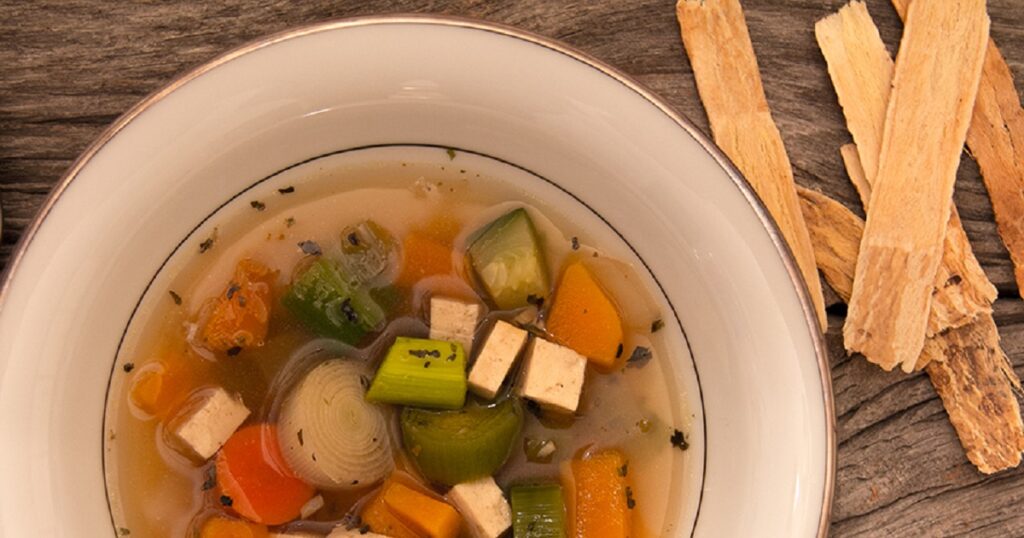Astragalus soup with miso

Warming and light
Astragalus root soup is light and digestible. It is distinguished by its very interesting woody flavor. It is garnished with vegetables and possibly also protein ingredients such as lentils, tofu or meat. Miso, broth and alliaceae such as leek, garlic and onion give it a salty and comforting flavor, enhanced with a few warming spices. At the same time, we benefit from the fabulous medicinal properties of astragalus, which can be found in detail in the article Astragalus, from wood to the hearth.
INSTRUCTIONS
Astragalus broth
- Boil the astragalus roots over low heat in 3 liters of water for 45 minutes.
- Filter the roots, which you can dispose of, and reserve the decoction thus obtained.
Astragalus soup
3 In a large pot, brown the onion, garlic, coriander seeds and ginger over low heat with a little vegetable oil until they brown slightly.
4 Add the astragalus decoction and bring it to a boil.
5 Add the carrots, butternut squash, leek, vegetable stock and simmer everything for 10 minutes.
6 Add celery, miso, cayenne, thyme, salt and pepper, simmer for another 10 minutes.
7 Add the chopped parsley, mix well and turn off the heat to let it cool a little.
8 Serve with a wedge of lemon or lime to add a touch of acidity.
NOTES
Therapeutic applications
Astragalus, Astragalus membranaceus or americanus , gradually and surely increases the vitality and the body’s ability to generate heat. At the same time, it consolidates the immune defenses in a lasting and profound way. These long-term effects can only be appreciated by consuming astragalus regularly, ideally over a period of two to eight weeks (avoid for pregnant women). To find out in detail the multiple medicinal virtues of astragalus, consult our article: Astragalus, from wood to the hearth .
Ayurvedic profile
Beneficial for: vata and kapha
Suitable for: pitta in moderate quantities
Dominant flavor: Mild/Sweet, Dirt
Secondary flavor: Spicy
INGREDIENTS
3 liters of water
1 cup of vegetable broth
30 g astragalus roots (about 15 pieces)
4 teaspoons of organic sunflower oil
1 finely chopped onion
4 chopped garlic wedges
2 tbsp crushed coriander seeds
2 tbsp grated fresh ginger (8 cm)
2 cups leek, sliced into strips (about 1)
2 cups diced butternut squash (about 1)
2 cups diced celery (about 3 stalks)
2 cups chopped carrots (about 3)
4 tbsp miso
¼ tsp ground cayenne pepper
1 tsp dried thyme
½ tsp salt
½ tsp pepper
¼ cup chopped fresh parsley
Lemon or lime (optional)
Variation for VATA types
-
- Double the amount of vegetable oil to increase the fat intake because vata is dry
- Optional: remove the cayenne, the recipe is sufficiently spicy for vata
- Optional: add about 2 cups of tofu, cooked lentils or meat, which are incorporated with the carrots to increase the caloric intake
Variations for PITTA types
-
- Remove the cayenne and halve the amount of ginger to reduce the spicy flavor
- Add 1 tbsp. of turmeric at the stage where we add salt and pepper, an anti-inflammatory spice beneficial to the liver
- Double the quantity of parsley, to have more alkalizing minerals
- Optional: add about 2 cups of tofu, cooked lentils or meat, which are incorporated with the carrots to increase the caloric intake
Variation for KAPHA types
-
- Double the amount of cayenne and ginger to increase the spiciness and activate the metabolism
- Double the amount of parsley, a low-calorie food rich in minerals
- Replace the squash with 2 cups of kale, which is added at the same time as the celery; kale is lighter and lower in calories than squash.
NOTES
Therapeutic applications
Astragalus, Astragalus membranaceus or americanus , gradually and surely increases the vitality and the body’s ability to generate heat. At the same time, it consolidates the immune defenses in a lasting and profound way. These long-term effects can only be appreciated by consuming astragalus regularly, ideally over a period of two to eight weeks (avoid for pregnant women). To find out in detail the multiple medicinal virtues of astragalus, consult our article: Astragalus, from wood to the hearth .